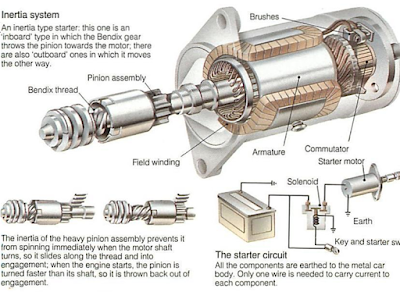Starting System of vehicle and
starter motor
Requirements of
Starting System
•
An internal combustion engine
requires the following criteria in order to start and continue running.
•
Combustible mixture.
•
Compression stroke.
•
A form of ignition.
•
The minimum starting speed (about 100
rev/min).
•
Long service life and maintenance
free.
•
Continuous readiness to operate.
•
Robust, such as to withstand starting forces,
•
Vibration, corrosion and temperature
cycles.
•
Lowest possible size and weight
•
In order to produce the first three
of requirements, the minimum starting speed must be achieved. This is where the
electric starter comes in.
The ability to reach this
minimum speed is again dependent on a number of factors.
•
Rated voltage of the starting system.
•
Lowest possible temperature at which it must
still be possible to start the engine. This is known as the starting limit
temperature.
•
Engine cranking resistance. In other words the
torque required to crank the engine at its starting limit temperature
(including the initial stalled torque).
•
Battery characteristics.
•
Voltage drop between the battery and the
starter.
•
Starter-to-ring gear ratio.
•
Characteristics of the starter.
•
Minimum cranking speed of the engine at the
starting limit temperature.
TYPES OF STARTER MOTOR
•
Inertia
Starter
•
Pre-Engaged
Starter
•
Permanent
Magnet Starter
•
Heavy
Vehicle Starter
•
Integrated
Starter
•
Reduction
Gear Starter
Inertia Starter Motor
Bendix Drive ( Inertia
Drive)
Working Principle of
Bendix Drive:
•
With the Bendix self-engaging pinion
drive, the armature shaft spins and the drive pinion stands still while
the threaded sleeve spins inside the pinion. As the sleeve spins, the pinion
slides out and meshes with the ring gear. As soon as the pinion reaches its
stop, the turning sleeve causes the pinion to turn with it to crank the engine.
•
In detail 1, the armature shaft and
pinion sleeve begin to spin. The stationary pinion is sliding to the left. In
detail 2, the sliding action is stopped, and the pinion begins to turn and
crank the engine. When the engine starts, detail 3, the pinion is spinning
faster than the threaded pinion sleeve. This spins the pinion back out of mesh
with the ring gear
Pre-Engaged Drives
•
Pre-engaged starters are fitted to
the majority of vehicles in use today. They provide a positive engagement with
the ring gear, as full power is not applied until the pinion is fully in mesh.
They prevent premature ejection as the pinion is held into mesh by the action
of a solenoid.
•
A one-way clutch is incorporated into
the pinion to prevent the starter motor being driven by the engine.
•
A Pre-engage starter motor is very
similar to an inertia starter however instead of using inertia to throw the
pinion out a small solenoid is used to engage the pinion before the armature
turns the engine over. A primary circuit throws the pinion out, once the
pinion has been thrown out power is feed to a second circuit to hold the pinion
in place as the armature turns







0 Comments